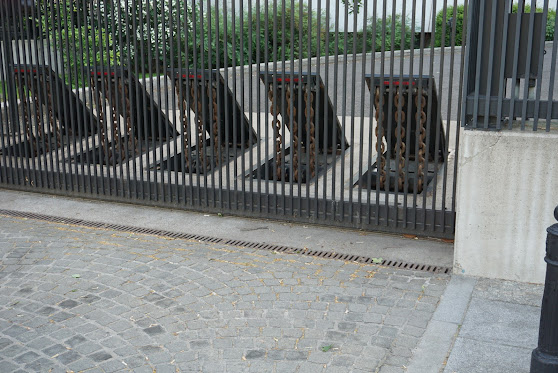Other countries in Warsaw
#Warsaw tour guide #Warsaw city guide # guided tour in warsaw #Warszawa tour guide #Warszawa city guide #guided tour in Warszawa
It’s exciting to experience a new city, but it’s also exciting to see other countries’ embassies – it gives you an impression of how those countries see themselves and how they would like to present themselves in that country.
The Russian Embassy – Address: ul. Belwederska 49. Approximately 15 minutes’ walk from Metro Pole Mokotowski.
A palatial building that displays the power of empire. It was built in the years 1954-1955 by Soviet labourers and Soviet building materials imported for the specific purpose.

It was erected almost simultaneously with the Palace of Culture, which was intended to be a monument to who was in charge in Poland. That was also the purpose of the embassy, which is located in a beautiful setting surrounded by some of Warsaw’s most beautiful parks. Most importantly, only a low wall separated it from the Polish Ministry of Defence, where the Polish-Russian (but clearly more Russian) General Konstanty Rokossowski was Minister of Defence in the years 1949 – 1956, and could be considered the Soviet representative in the Polish government (in 1956 he left for the Soviet Union, where he became the Soviet Deputy Minister of Defence). And right opposite the Ministry of Defence is the Belweder, the Polish state administration’s most prestigious representative building.
The Saudi Embassy – Adresse: ul. Wiertnicza 30. Bus 116 to the final station (close to the Palace in Wilanów).
For a medium-sized distant country with limited contacts in Poland, the Saudi embassy is quite impressive, housing over 30 diplomats doing Allah-knows-what in Poland.

The Saudi Arabian Embassy was built by the Saudi government in 2015. It consists of two floors, in addition to the ground floor, but the height makes it seem much larger. It is clearly inspired by Arabic architecture, but its symmetrical shape also includes Polish elements. Interestingly, it is located in the historic Wilanów area, close to the old summer residence of King Sobieski, but also just a short stroll from one of the capital’s newest residential areas and the newly built Sanctuary of God’s Providence with its Papal Museum.
The Dutch Embassy. Address: Kawalerii 10.
If you want to move your legs, it’s worth continuing the descent from Ujazdowski Castle to reach the Dutch Embassy from 2004.

The fence around the embassy protects against murderous terrorists, but is also friendly and inviting in its shape and it blends in with the surrounding vegetation. The embassy appears light and classic, with great lighting. In short – a building that shows kindness and determination.
Embassy of the United Kingdom. Address: ul. Kawalerii 12.
From 2009 British Embassy and Ambassador’s residence.

With the double glazing and vertical panels, it feels like an open embassy despite the railings, although they will now have to struggle to live up to the friendly attitude of the Dutch in the neighbouring building.
US Embassy. Address: Al. Ujazdowskie 29/31. 10 minutes’ walk from Politechnika Metro.
With over 80 diplomats, the embassy emphasises the “special relationship” that Poland in particular likes to emphasise with the US. It’s a big brother-little brother relationship, and the US shows brotherly feelings when they feel like it. Here, however, the embassy is a practical office building in a modernist style, which is thoroughly cordoned off with efficient chains that are probably both practical and symbolic.

Americans also allow themselves to give Poland the finger when they feel like it, as in the case of the homophobic rhetoric in some parts of the Polish society. Here, Stars and Stripes is flanked by all the colours of the rainbow – something that would make any proper homophobe turn red hot.

The US Embassy is a large complex and surrounds the Swiss Embassy, located on the corner of Ujazdowska Street and Piękna Street. On Piękna Street you’ll find the consular section, where aspiring Poles queued for a visa until the visa requirement was abolished a few years ago.

US Embassy – Consular Section
The Swiss Embassy. Address: Al. Ujazdowskie 27. 10 minutes’ walk from Politechnika Metro.
The embassy is located in a corner property in a classic mansion, surrounded on both sides by the US Embassy. The property was built in 1868 and renovated after a fire during WWII.

This is a well-designed and well-maintained patrician villa that clearly exudes Swiss solidity, a place you can trust.
The French Embassy. Address: ul. Piękna 1 – 10 minutes’ walk from Politechnika Metro.
The embassy expresses a slightly dilapidated elegance with its glass and design, and its size clearly expresses the awareness of being a mighty power. The decay is unlikely to be deliberate, while the rest of the elements are probably planned, and the French state places great emphasis on cultural dissemination.

The building was built by the French state, and de Gaulle himself laid the foundation stone for the building, which was completed in 1971. Intended to showcase the very best of French architecture, it still stands as one of the gems among the capital’s embassies.
The Chinese Embassy. Address: Bonifraterska 1. Ten minutes’ walk from Ratusz Arsenał Metro.
When you pass the building, you have no doubt that this is where the Chinese live, but in fact the building was designed by Polish architects and completed in 1959. With 35 diplomats, this is a significant representation, but of course it is also the representative of the world’s most populous nation.

The building is protected in a fairly discreet way and the complex exudes both power and harmony. The embassy’s employees predominantly reside in apartment blocks adjacent to the embassy.
The Danish Embassy. Address: ul. Marszałkowska 142 – 200 metres from Świętokrzyska Metro.
In 2006, the Danish Embassy in Warsaw moved from a fine representative embassy building to make room for the expanding trade department that was deemed necessary after Poland’s membership of the EU.

The Danish Embassy occupies two full floors of this office palace in the centre of Warsaw. The Danish King hasn’t sent too many diplomats to Warsaw, but the building sends a clear signal about the purpose of Denmark’s diplomatic representation in Poland – solid competition for the big international consultancy firms.
The Swedish Embassy. Address: ul. Bagatela 3. Around the corner from the Prime Minister’s office. 15 minutes’ walk from Politechnika Metro.
Designed by Swedish architect Curt Björklund and built in 1938. Repaired after minor damage during WWII.
The construction is simple and principled, but the copper roof and elaborate columns still elevate the building to something special.

Its location in close proximity to the Polish centre of power (president and prime minister) has significant symbolic meaning. Located at the same address since 1938, the Swedes also symbolise continuity.
The Spanish Embassy. Address: ul. Myśliwiecka 4.
The Spanish Embassy is shrouded in trees and in summer it can be difficult to photograph the building. Like many embassies, this one was designed and built by the Spanish government.

The low white building expresses both something mighty and imperial, but is at the same time modest in its expression. You can clearly feel southern Spain and Moorish heritage in the construction.
The Holy See’s Nuncio in Warsaw (Nuncjusz apostolski). Address: Aleja Szucha 12. 15 minutes’ walk from Politechnika Metro.
Poland’s diplomatic relations with the Holy See date back to the Middle Ages, with a break during Russian rule 1795-1918 and a brief interruption during and after WWII.

Mansion from 1912, bombed during WWII, but rebuilt. It’s a small “embassy” with two diplomats, but in terms of size, the Vatican is obviously not a superpower. In return, the building sends signals of dignity and power, flanked by statues of great Poles, including of course the late Polish Pope and current saint, John Paul 2. Poland’s relationship with the Vatican is regulated by the Concordat, an agreement that guarantees the rights of the church in Poland.
The Japanese Embassy. Address: ul. Szwoleżerów 8
The impressive Japanese Embassy was built in 2000 in this new embassy neighbourhood, close to the Dutch and British embassies, and like them was built by the Japanese government.

The building emits some technological signals, including from the solar panels on the roof. However, just as this photo is being taken, the guard is manually trying to push the gate aside. Behind the embassy, the ambassador’s personal residence is located in a building that clearly shows that an ambassador is an important person.
The Turkish Embassy. Address: Rakowiecka 19. Approximately 5 minutes’ walk from Metro Pole Mokotowski.
Poland’s diplomatic relations with Turkey date back to the Middle Ages, when the Polish-Lithuanian Union and Turkey were two of Europe’s most important powers, and also bordered each other. There were frequent wars, but also a mutual respect.

The building dates from 1926 and has previously served as the embassy of the Netherlands and from 1996-2006 the Danish embassy was housed here until the expanding trade department led to a move to an office block. The building was modernised in 2013 and is currently a modern, efficient looking building.
Please send an email to m@hardenfelt.pl if you would like an English-speaking tour guide to show you the most important places in Warsaw.
